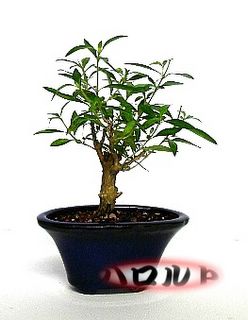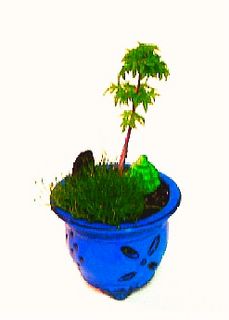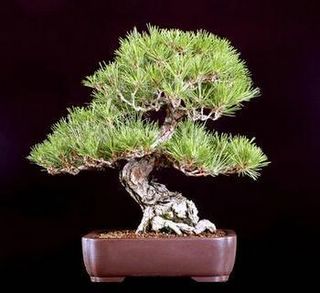Hi and welcome to anyone that may be interested in the most rewarding of all horticulture endeavors that you could possibly ever master.
I’m referring of course to the art of creating your very own living breathing bonsai.
I want to tell you a story of how I first became hooked on this wonderful hobby.
It all happened when I was a teenager living with my grandmother.
My grandmother had a really beautiful front yard and in her yard at the front gate was a huge flower trestle. Planted on one side of this trestle was wisteria.
My grand parents bought the home in 1901 and the wisteria was already growing there at the front gate when they bought the home. The trunk at ground level was really huge.
By huge I mean over a foot around and that my friend is considered very big for wisteria.
It had been there for many years and had grown to completely cover the entire trestle and was to me absolutely astounding and very beautiful.
But as life would have it my grandmother became tired of the plant because of her age and failing health and wanted it removed.
Well guess who got that task? Yea you guessed it me. Well by that time in my life I was around sixteen or so I considered myself up to the task.
I hated having been given the job of getting rid of the wisteria however because as I said to me the plant was simply too beautiful to destroy.
But a job was a job and I knew that I would get paid so I started cutting it down.
I cut away at that plant for nearly the entire day and made a huge pile of branches out near the back of the barn where my granddad had a burn pile.
The main trunk took several more days for me to extract from the ground because like I said it was huge and it had a tap root that was very deep and the darn thing simply hung on for dear life.
I pried and dug till I was blue in the face and simply could not get the darn thing out of the ground. Well the next day was the weekend and I got up early and continued to dig on the wisteria.
Weekends were always my favorite time because you see in the days when I was growing up if you were lucky to have the money you could go to the Saturday movies in the afternoon.
You could even get a huge bag of popcorn and a soft drink for a quarter. Yes you read right a whopping quarter.
Well I wanted desperately to see a movie that Saturday, it was a western and westerns were my favorite. To give you an idea of the generation gap the name of the movie for anyone interested was PILLARS OF THE SKY and stared my favorite female actress Dorothy Malone.
Anyway I could not get the money my grandmother owed me till the job was complete so I kept on digging and prying trying to get that darned old wisteria stump out of the ground.
Well call it a twist of fate or luck of what ever you like but all of a sudden I heard some one behind me asking if they could help.
When I turned around to reply I was to see and meet for the first time in my life the man who later in my life taught me more about this wonderful art form than any other person most likely has or ever could have.
If I had been older at the time the little old man behind me would have perhaps reminded me of the movie actor that played the title role in The Karate Kid…. Pat Morita or better known as Miyagi.
Anyway the little short and nearly bald Japanese fellow was standing there looking at me like I was crazy to be working so hard and ask again if he could help and I said yes of course because at that point all I wanted to do was get done so I could go collect my money and head off to the movies.
Well as the man helped me to get the stump out of the ground he kept asking if he could have it. Of course I was more than happy to give it to him as it would be just one less thing I would had to throw on the burn pile.
Anyway to finish up the story the man did help me get the stump out of the ground and he when he left that day he took the stump along in his truck.
As fate would have it I ran into this man again a couple of years later and he invited me to his home to see his bonsai collection and to also get a look at what I worked so hard to get out of the ground.
Yes my friends the old stump from that wisteria that I was in such a hurry to get rid of.
Well my friends that is the day I really became hooked on bonsai, because if any of you ever in your life wondered want a masterpiece of creative art preformed on a plant looks like you would have seen it that day.
This fellow indeed was genius and a master at the art of bonsai. Yes indeed he was he had taken what was nearly a totally destroyed wisteria stump and some how saved and transformed it into perhaps one of the most lovely and beautiful bonsai that I have ever seen in my entire lifetime so far.
Now imagine if you will a stump that is nearly 22 inches in diameter and only about 16 inches in height but covered in the vine likeness that only wisteria can produce and loaded with beautifully shaped clusters of fragrant flowers as they hung down from the plant.
This was all planted in a bonsai pot that was not like any I had ever seen or have seen since. It was obvious that this pot was very special and most likely from his home land and antique.
Not like any you would find in any nursery here in the states unless it was special ordered.
Anyway to sum up my story I was astonished that the plant even lived at all.
You see I had really never thought about it after the day he took the stump until just then again at that oh so magic moment when I stood there in total amazement looking at what once used to be in my grandmother’s yard.
If I had known the day we dug it up what I know now that bonsai would be in my collection and I would probably still be enjoying it now.
I trained with this man until the time of his death in the early 1970s and I have never to this day ever had any regrets even for one moment of the gentle and caring wisdom he so graciously imparted to me.
I’m sixty one years old now and I still enjoy bonsai and I work at it nearly every day of the year when I get the chance.
It has become my life long passion and one true love other than my family of course and I will be writing about it here in my blog as time permits so if you like bonsai and the art of creating them then you may want to look in on the blog once in a while and read my ramblings.
I will be writing about bonsai and relating information about the art and what I have learned in my life time about bonsai. I will share with anyone that has an interest the tricks and facts that I have learned in my hobby and how you too can enjoy this most wonderful past time if your so inclined.
Respectfully yours, Harold Yearout





